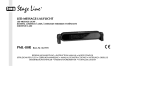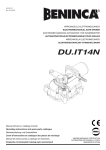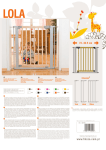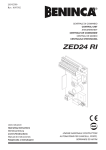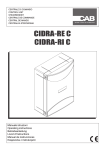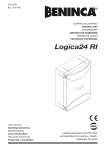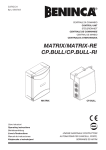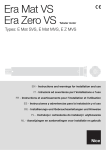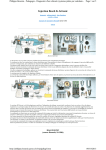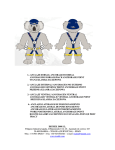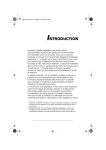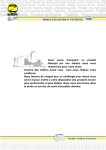Download MBE - Vratcom
Transcript
L8542336 Rev. 07/04/02 CENTRALE DI COMANDO CONTROL UNIT STEUEREINHEIT CENTRALE DE COMMANDE CENTRAL DE MANDO CENTRALKA STEROWANIA MBE Libro istruzioni Operating instructions Betriebsanleitung Livret d’instructions Manual de instrucciones Książeczka z instrukcjami UNIONE NAZIONALE COSTRUTTORI AUTOMATISMI PER CANCELLI, PORTE, SERRANDE ED AFFINI Dichiarazione CE di conformità EC declaration of confirmity EG-Konformitatserklarung Déclaration CE de conformité Declaracion CE de conformidad Deklaracja UE o zgodności Con la presente dichiariamo che il nostro prodotto We hereby declare that our product Hiermit erklaren wir, dass unser Produkt Nous déclarons par la présente que notre produit Por la presente declaramos que nuestro producto Niniejszym oświadczamy że nasz produkt MBE è conforme alle seguenti disposizioni pertinenti: complies with the following relevant provisions: folgenden einschlagigen Bestimmungen entspricht: correspond aux dispositions pertinentes suivantes: satisface las disposiciones pertinentes siguientes: zgodny jest z poniżej wyszczególnionymi rozporządzeniami: Direttiva sulla compatibilità elettromagnetica (89/336/ CCE, 93/68/CEE) EMC guidelines (89/336/EEC, 93/68/EEC) EMV-Richtlinie (89/336/EWG, 93/68/EWG) Directive EMV (89/336/CCE, 93/68/CEE) (Compatibilité électromagnétique) Reglamento de compatibilidad electromagnética (89/336/ MCE, 93/68/MCE) Wytyczna odnośnie zdolności współdziałania elektromagnetycznego (89/336/EWG, 93/68/EWG) Direttiva sulla bassa tensione (73/23/CEE, 93/68/CEE) Low voltage guidelines (73/23/EEC, 93/68/EEC) Tiefe Spannung Richtlinie (73/23/EWG, 93/68/EWG) Directive bas voltage (73/23/CEE, 93/68/CEE) Reglamento de bajo Voltaje (73/23/MCE, 93/68/MCE) Wytyczna odnośnie niskiego napięcia (73/23/EWG, 93/ 68/EWG) Norme armonizzate applicate in particolare: Applied harmonized standards, in particular: Angewendete harmonisierte Normen, insbesondere: Normes harmonisée utilisées, notamment: Normas armonizadas utilzadas particularmente: Normy standard najczęściej stosowane: Norme armonizzate applicate in particolare: Applied harmonized standards, in particular: Angewendete harmonisierte Normen, insbesondere: Normes harmonisée utilisées, notamment: Normas armonizadas utilzadas particularmente: Normy standard najczęściej stosowane: EN 55022, EN 61000-3-2, EN 61000-3-3, EN 50082-1 EN 60204-1, EN 60335-1 Data/Firma Data/Firma Automatismi Benincà SpA Via Capitello, 45 36066 Sandrigo (VI) ITALIA 2 # Ingresso pulsante pedonale # Input, pedestrian entrance push-button # Eingang, Fußgängereingang Taste # Entrée bouton entrée piétonne # Entrada pulsador entrada de peatones # Wejście dla przycisku nożnego 0 NT 0 120 12 155 POWER 24 190 230 FT SHIELD N.O. P.P. N.C. STOP FTC N.C. D5 3 4 5 6 7 8 9 10 11 SCA 24Vac 3W max RADIO 1 2 ANT ANT +V 24Vac 0,5A max ELS 12Vac D4 PGM 1 P.P. Mod 2 C.A. 3 Cond. 4 Prelamp. 24V 12V 0V Power NT FT 12 13 14 15 16 17 D2 F2 2A F1 6.3A 18 19 20 21 L 230VAC 50Hz N 22 23 24 25 26 COM LAMP 230Vac C MB C MBE 3 Centrale di comando per MBE La centrale elettronica MBE può essere utilizzata per il controllo di 1 o 2 motori MB/MBE. AVVERTENZE GENERALI a) L’installazione elettrica e la logica di funzionamento devono essere in accordo con le normative vigenti. b) I conduttori alimentati con tensioni diverse, devono essere fisicamente separati, oppure devono essere adeguatamente isolati con isolamento supplementare di almeno 1 mm. c) I conduttori devono essere vincolati da un fissaggio supplementare in prossimità dei morsetti. d) Ricontrollare tutti i collegamenti fatti prima di dare tensione. e) Controllare che le impostazioni dei Dip-Switch siano quelle volute. f) Gli ingressi N.C. non utilizzati devono essere ponticellati. FUNZIONI INGRESSI/USCITE N° Morsetti Funzione Descrizione 1 ANT Segnale Antenna. 2 SHIELD Schermo Antenna. 3-8 SCA Collegamento spia cancello aperto 24 Vac/3W max. 4 Passo-Passo Ingresso pulsante passo-passo N.O. 5 STOP Ingresso pulsante STOP N.C. 6 FTC Ingresso collegamento dispositivi di sicurezza, contatto N.C. (ad es. fotocellule) 7 +V Comune per tutti gli ingressi di comando. 8-9 24 Vac Uscita alimentazione accessori 24Vac/0,5A max. 10-11 ELS Collegamento elettroserratura 12Vac/0,5A max. 12-13-14 24-12-0 Collegamento avvolgimento secondario trasformatore 15-16-17 POWER-NT-FT Collegamento avvolgimento primario trasformatore 18-19 Alimentazione Ingresso 230 Vac 50Hz (18-fase/19-neutro) 20-21 LAMP Uscita collegamento lampeggiante 230Vac 40W max. 22-23-24 Motore MB Collegamento al motore MB (senza centrale di comando): (22-marcia/23-marcia/24 com) 24-25-26 Motore MBE Collegamento al motore MBE (con centrale di comando): (24-com/25-marcia/26 marcia) # Pedonale Se si desidera utilizzare l’ingresso pedonale collegare un pulsante normalmente aperto (N.O.) tra +V (comune dei comandi) ed il piolino posto vicino al morsetto STOP (vedi schema). Verifica collegamenti: Dopo aver regolato i finecorsa come indicato nel manuale istruzioni dell'attuatore, procedere come segue: 1) Togliere alimentazione. 2) Sbloccare manualmente le ante, portarle a circa metà della corsa e ribloccarle. 3) Ripristinare l’alimentazione. 4) Dare un comando di passo-passo mediante pulsante o radiocomando. 5) Le ante devono muoversi in apertura. Nel caso ciò non avvenisse, è sufficiente invertire tra loro i fili di marcia del motore. (22/23 per il motore MB, e 25/26 per il motore MBE). 6) Procedere con la regolazione dei Tempi e delle Logiche di funzionamento e della potenza motore. Regolazione della potenza motore ATTENZIONE! Questa regolazione influisce sul grado di sicurezza dell’automazione. Verificare che la forza applicata sull’anta sia conforme con quanto previsto dalle normative vigenti. Sul trasformatore di alimentazione è presente un connettore Faston (POWER) che permette la regolazione della potenza dei motori su 3 diversi livelli. Posizionando il Faston (POWER) su 120 si ha la potenza minore, spostandolo su 190 si ha la potenza maggiore. ATTENZIONE!: Non essendo l'attuatore MB/MBE dotato di frizione meccanica regolabile, il faston POWER non deve mai essere portato in posizione 230V. 4 Funzione Dip-Switch DIP 1 “P.P. Mod” Seleziona la modalità di funzionamento del ”Pulsante P.P.” e del trasmettitore. Off: Funzionamento: APRE > STOP > CHIUDE > STOP > On: Funzionamento: APRE > CHIUDE > APRE > DIP 2 “C.A.” Abilita o disabilita la chiusura automatica. Off: chiusura automatica disabilitata On: chiusura automatica abilitata DIP 3 “Cond.” Abilita o disabilita la funzione condominiale. Off: Funzione condominiale disabilitata. On: Funzione condominiale abilitata. L’impulso P.P. o del trasmettitore non ha effetto durante la fase di apertura. DIP 4 “Prelam.” Abilita o disabilita il prelampeggio Off: Prelampeggio disabilitato On: Prelampeggio abilitato. Il lampeggiante si attiva 3 s prima della partenza del motore. Nota: Dopo ogni modifica delle impostazioni dei trimmer e dei Dip-switch, togliere e ridare alimentazione di rete. Funzione dei Trimmer TCA Permette di regolare il tempo di chiusura automatica. Verificare il Dip-Switch N°2= On. La regolazione varia da un minimo di 1 s ad un massimo di 125 s TL Regola la durata massima della manovra di apertura e chiusura. Deve essere impostato circa 4 sec. in più rispetto al tempo di corsa effettiva dell’automatismo. La regolazione varia da un minimo di 5 s ad un massimo di 130 s Nota: Nel caso di apertura/chiusura parziale, la centrale calcola il tempo restante al completamento della manovra, in modo da evitare inutili surriscaldamenti del motore. TRAC Permette di regolare il tempo di ritardo con cui il motore MBE inizia la manovra di chiusura rispetto al motore MB. La regolazione varia da un min. di 3 s a un max. di 30 s. In apertura il tempo di sfasamento dei motori è di 2 secondi. Configurazione ricevitore incorporato La centrale è dotata di un modulo radio incorporato per la ricezione di telecomandi sia a codice fisso che a codice variabile alla frequenza di 433.92MHz. Per utilizzare un telecomando è prima necessario apprenderlo, la procedura di memorizzazione è illustrata di seguito, il dispositivo è in grado di memorizzare fino a 14 codici diversi. Memorizzazione di un nuovo trasmettitore con attivazione funzione P.P. - Premere 1 volta il pulsante PGM per 2 secondi, il led D4 inizia a lampeggiare velocemente. - Premere entro 10s il pulsante del trasmettitore che si desidera memorizzare con funzione P.P. Cancellazione dei telecomandi dalla memoria - Togliere alimentazione alla centrale - Ripristinare l’alimentazione mantenendo premuto il pulsante PGM per 5 secondi, il led D4 si accende a luce fissa e si spegne a cancellazione avvenuta. - Rilasciare il pulsante PGM, la memoria è stata cancella ed il LED D4 riprende a lampeggiare normalmente. NOTA: Se entrando nella procedura di memorizzazione dei trasmettitori il LED D4 emette due lampeggi lunghi e si spegne, significa che la memoria della ricevente è piena e non è possibile memorizzare altri trasmettitori. Funzioni LED LED D2 Acceso in presenza alimentazione di rete LED D4 Programmazione ricevitore radio LED D5 Si accende in presenza di segnali radio sulla frequenza del modulo incorporato. 5 MBE control unit The electronic control unit MBE can be used to control 1 or 2 motors MB/MBE. GENERAL WARNINGS a) The wire connections and the operating logic should be in compliance with regulations in force. b) The cables featuring different voltage should be physically detached, or adequately insulated by an additional insulation of at least 1 mm. c) The cables should be further fastened in proximity to the terminals. d) Check all connections before powering the unit. e) Check that settings of the Dip-switches are the required ones. f) The N.C. inputs which are not in use should be short-circuited. INPUT/OUTPUT FUNCTIONS Terminal No. Function Description 1 ANT Antenna Signal 2 SHIELD Antenna Shield 3-8 SCA Indicator lamp, Open gate 4 P-P Input, N.O. step-by-step push-button 5 STOP Input, N.C. STOP push-button 6 FTC Input, safety devices connection, N.C. terminal (e.g. photocells) 7 +V Common to all control inputs. 8-9 24 Vac Output, accessories power supply 24Vac/0,5 A max. 10-11 ELS Electric lock connection, 12Vac/0,5A max. 12-13-14 24-12-0 Connection to transformer secondary winding 15-16-17 POWER-NT-FT Connection to transformer primary winding 18-19 Power supply Input, 230Vac 50Hz (18-Phase/19-Neutral) 20-21 LAMP Output, flashing light connection, 230Vac 40W max. 22-23-24 MB Motor Connection to MB motor (without control unit): (22-movement/23-movement/24 com) 24-25-26 MBE Motor Connection to MBE motor (with control unit): (24-com/25-mouvement/26 movement) # Pedestrian To use the pedestrian entrance, connect the normally open (N.O.) pushbutton between +V (control common) and the little knob near terminal STOP (see wire diagram). To check connections: After adjusting the limit switches as shown in the actuator instruction manual, proceed as follows: 1) Cut-off power supply. 2) Manually release the wings, move them to approx. half-stroke and lock them again. 3) Reset power supply. 4) Send a step-by-step control signal by pressing the button or the remote control key. 5) The wings should start an opening movement. If this is not the case, invert the movement wires of the motor. (22/23 for motor MB, and 25/26 for motor MBE). 6) Adjust Time, Operating Logic and Motor Power. To adjust the motor power WARNING! This adjustment affects the safety of the automatic system. Check that the thrust applied onto the wing complies with regulations in force. A Faston (POWER) connector is provided on the power supply transformer which allows the power adjustment of the motors on 3different levels. By moving the Faston (POWER) to 120, power is at minimum, by moving it to 190, power is at maximum. WARNING! : As the MB/MBE actuator is not equipped with adjustable mechanical clutch, the POWER faston must never be moved to 230V position. 6 Dip-Switch functions DIP 1 “P.P. Mod” The operating mode of ”Pulsante P.P.” (Step-by-step push button) and of the transmitter is selected. Off: operation : APRE > STOP > CHIUDE > STOP > On: operation: APRE > CHIUDE > APRE > DIP 2 “C.A.” Automatic closure is enabled or disabled. Off: disabled automatic closure On: enabled automatic closure DIP 3 “Cond.” The multi-flat function is enabled or disabled. Off: disabled multi-flat function. On: enabled multi-flat function. The P.P. (Step-by-step) impulse or the impulse of the transmitter have no effect in the opening phase. DIP 4 “Prelam.” Forewarning flashing light enabled or disabled Off: disabled forewarning flashing light On: enabled forewarning flashing light. The flashing light is activated 3 s before the motor starts. Note: After modifying the setting of trimmers and Dip-Switches, switch off and power the unit again. Functions of Trimmers TCA TL TRAC The automatic closure time can be adjusted with this trimmer. Check Dip-switch N°2= On. This function can be adjusted between 1 s minimum and 125 s maximum The maximum time of the opening and closing phases can be adjusted with this trimmer. Time should be preset approx. 4 sec. longer than the actual stroke time of the automatic system. Adjustment ranges from 5 s minimum to 130 s maximum Note: In the event of partial opening/closing, the control unit calculates the remaining time to complete the operation in order to avert useless overheating of the motor. It allows to adjust the delay time with which motor MBE starts closing with respect to motor MB. Adjustment range from 3 s minimum to 30 s maximum. During opening, the out of phase time of the motors is 2 seconds. Configuration of the built-in receiver The control unit is complete with an incorporated radio receiver for both fixed-code and variable code radio controls, at 433.92MHz frequency. To use a radio control, its code should be copied first. The memorization procedure is shown here under. The device is able to store up to 14 different codes in memory. Memorization of a new transmitter with activation of the P.P. (step-by-step) function - Press PGM button once for 2 seconds, the D4 LED starts flashing rapidly. - Within 10s, press the transmitter push-button which should be stored in memory with P.P. function. To delete the control unit codes from memory - Cut-off power supply to the control unit - Reset power supply by keeping the PGM button pressed for 5 seconds; the D4 LED switches on with fixed light and then off when deletion is completed. - Release the PGM button, memory is deleted and the D4 LED starts flashing regularly again. NOTE: If the D4 LED switches on with two long flashes and then switches off, when entering the transmitter codes memorization mode, this means that the receiver is full and no other transmitter code can be stored in memory. LED functions LED D2 Access when the unit is powered LED D4 Radio receiver programming LED D5 This LED switches on when radio signals are received on the built-in module frequency. 7 Steuerung für ”MBE” Die elektronische Zentrale MBE kann zur Steuerung von 1 oder 2 Motoren MB/MBE verwendet werden. ALLGEMEINE HINWEISE a) Die elektrische Installation und die Betriebslogik müssen den geltenden Vorschriften entsprechen. b) Die Leiter die mit unterschiedlichen Spannungen gespeist werden müssen physisch getrennt oder sachgerecht mit einer zusätzlichen Isolierung von mindestens 1 mm isoliert werden. c) Die Leiter müssen in der Nähe der Klemmen zusätzlich befestigt werden. d) Alle Anschlüsse nochmals prüfen, bevor die Zentrale mit Strom versorgt wird. e) Kontrollieren, ob die Dip-Schalter richtig positioniert sind. f) Die nicht verwendeten N.C. Eingänge müssen überbrückt werden. FUNKTIONEN EINGÄNGE/AUSGÄNGE Anzahl Klemmen Funktion Beschreibung 1 ANT Antennensignal 2 SHIELD Antennenabschrimung 3-8 SCA Anschluss Meldeleuchte Tor offen 24 Vac/3W max. 4 P-P Eingang Schritt-Schritt-Taste N.O. 5 STOP Eingang Taste STOP N.C. 6 FTC Eingang Anschluss Sicherheitsvorrichtungen, Kontakt N.C. (z.B. Fotozellen) 7 +V Allgemein für alle Steuerungseingänge. 8-9 24 Vac Ausgang Speisung Zubehör 24Vac/0,5A max. 10-11 ELS Anschluss an das Elektroschloss 12Vac/0,5A max. 12-13-14 24-12-0 Anschluss Wicklung sekundäres Trafo 15-16-17 POWER-NT-FT Anschluss Wicklung primäres Trafo 18-19 Speisung Eingang 230Vac 50Hz (1-Phase/2-Nulleiter) 20-21 LAMP Ausgang Anschluss Blinkleuchte 230Vac 40W max. 22-23-24 Motor MB Anschluss an den Motor MB (ohne Steuereinheit): (22-Betrieb/23-Betrieb/24 com) 24-25-26 Motor MBE Anschluss an den Motor MBE (mit Steuereinheit): (24-com/25-Betrieb/26 Betrieb) # Fußgänger Will man den Fußgängereingang verwenden, die Taste N.O. zwischen +V (allgemein für Steuerungen) und der Sprosse in der Nähe der Klemme STOP (siehe Plan) anschließen. Anschlüsse überprüfen: Nachdem die Endschalter laut Anweisungen des Aktuatoren-Handbuchs eingestellt worden sind, folgendermaßen vorgehen: 1) Stromversorgung abtrennen. 2) Von Hand die Torflügel entsichern, bis auf halbem Hub führen und wieder blockieren. 3) Wieder Strom geben. 4) Einen Schritt-Schritt-Befehl über die Taste oder die Fernsteuerung geben. 5) Die Torflügel müssen sich öffnen. Anderenfalls die Leiter für den Betrieb des Motors (22/23 für den Motor MB, und 25/26 für den Motor MBE) umkehren. 6) Nun Zeiten, Betriebslogik und Motorleistung einstellen. Motorleistung einstellen ACHTUNG! Diese Einstellung hat Einfluss auf die Sicherheit der Automatik. Die für das Tor angewendete Kraft muss den geltenden Vorschriften entsprechen. Der Speisetrafo ist mit einem Faston (POWER) Verbinder versehen, durch den die Motorleistung auf 3 verschiedene Stufen eingestellt werden kann. Wird der Faston (POWER) Verbinder auf 120 eingestellt, wird die Motorleistung auf das Minimum geregelt; wird er auf 190 eingestellt, wird die maximale Motorleistung erreicht. ACHTUNG!: Da der Aktuator MB/MBE nicht mit einer einstellbaren mechanischen Kupplung ausgestattet ist, darf der Faston POWER niemals auf die Position 230V positioniert werden. 8 Dip-Schalter-Funktionen DIP 1 “P.P. Mod” Wählt die Betriebsart der „Taste P.P.“ und des Sendegeräts. Off: Betrieb: ÖFFNEN > STOPP > SCHLIESSEN > STOPP On: Betrieb: ÖFFNEN > SCHLIESSEN > ÖFFNEN DIP 2 “C.A.” Aktiviert oder deaktiviert den automatischen Schließvorgang. Off: automatischer Schließvorgang deaktiviert On: automatischer Schließvorgang aktiviert DIP 3 “Cond.” Aktiviert oder deaktiviert die Funktion Wohngemeinschaft. Off: Funktion Wohngemeinschaft deaktiviert. On: Funktion Wohngemeinschaft aktiviert. Auf den Öffnungsvorgang haben weder der Schritt-Schritt-Impuls noch der Impuls des Sendegeräts Einfluss. DIP 4 “Prelam.” Aktiviert oder deaktiviert das Vorblinken. Off: Vorblinken deaktiviert On: Vorblinken aktiviert. Das Vorblinken beginnt 3 sec. vor dem Einschalten des Motors. Bemerkung: Nach jeder Änderung der Trimmer- und Dip-Schalter-Einstellungen, das Gerät stromlos machen und dann wieder an das Stromnetz anschließen. Trimmer-Funktionen TCA TL TRAC Ermöglicht es die Zeit des automatischen Schließvorgangs einzustellen. Kontrollieren ob Dip-Schalter Nr. 2= On. Die Zeit kann zwischen 1 sec. und maximal 125 sec. eingestellt werden. Stellt die maximale Zeit des Öffnungs- und Schließvorgangs ein. Die Zeit muss ungefähr 4 sec. länger sein als die die für den tatsächlichen Hub der Automatik benötigt wird. Die Zeit kann zwischen 0 sec. und maximal 130 sec. eingestellt werden. Bemerkung: bei unvollständigem Öffnungs-/Schließvorgang rechnet die Zentrale die restliche Zeit bis zur Vervollständigung der Bewegung aus, um den Motor nicht unnötig zu belasten und zu überhitzen. Ermöglicht es die Verzögerung mit welcher der Motor MBE den Flügel im Verhältnis zum Motor MB schließt, einzustellen. Die Zeit kann zwischen 3 s und max. 30 sec. eingestellt werden. Beim Öffnen beträgt der Unterschied zwischen den Motoren 2 Sekunden. Konfiguration des eingebauten Empfängers Die Zentrale ist mit einem eingebauten Funkmodul für den Empfang von Fernbedienungen mit festem Code und mit variablen Code, mit einer Frequenz von 433.92MHz ausgestattet. Um eine Fernbedienung verwenden zu können, muss diese zuerst erlernt werden; die Speicherungsprozedur ist nachstehend beschrieben. Das Gerät kann bis zu 14 unterschiedliche Codes speichern. Speicherung eines neuen Sendegeräts mit Aktivierung der Schritt-Schritt-Funktion - 1 Mal die Taste PGM 2 Sekunden lang drücken, die Leuchte D4 beginnt schnell zu blinken. - Innerhalb von 10 sec. die Taste des Sendegeräts drücken, das mit der Schritt-Schritt-Funktion gespeichert werden soll. Fernbedienungen aus dem Speicher löschen - Zentrale stromlos machen - Wieder Strom geben und gleichzeitig die Taste PGM 5 Sekunden lang gedrückt halten; die Leuchte D4 leuchtet fest und erlischt nach erfolgter Löschung. - Taste PGM wieder loslassen; nun ist der Speicher leer und die Leuchte D4 blinkt wieder wie üblich. BEMERKUNG: Wenn die Speicherungsprozedur der Sendegeräte abgerufen wird und die Leuchte D4 zwei Mal lang blinkt und dann erlischt, bedeutet dies dass der Speicher des Empfängers voll ist und das keine weiteren Sendegräte gespeichert werden können. Funktionen der LEUCHTEN LED D2 Leuchtet bei Stromversorgung LED D4 Programmierung Funkempfänger LED D5 Leuchtet bei Funksignalen auf der Frequenz des eingebauten Moduls. 9 Centrale de commande pour MBE La centrale électronique MBE peut être utilisée pour le contrôle d’un ou de deux moteurs MB/MBE. AVERTISSEMENTS GENERAUX a) L’installation électrique et la logique de fonctionnement doivent être conformes aux normes en vigueur. b) Les conducteurs alimentés avec tensions différentes doivent être séparés physiquement ou adéquatement isolés avec une isolation supplémentaire d’au moins 1 mm. c) Les conducteurs doivent être contraints par une fixation supplémentaire à proximité des bornes. d) Contrôler à nouveau toutes les connexions faites avant de mettre sous tension. e) Contrôler que les programmations des Dip-Switch sont celles désirées. f) Les entrées N.C. non utilisées doivent être fixées avec pontets. FONCTIONS ENTREES/SORTIES N° Bornes Fonction Description 1 ANT Signal Antenne 2 SHIELD Blindage Antenne 3-8 SCA Connexion voyant portail ouvert 24 Vac/3W max. 4 P-P Entrée touche pas à pas N.O. 5 STOP Entrée touche STOP N.C. 6 FTC Entrée connexion dispositif de sécurité, contact N.C. (es. photocellules) 7 +V Commun pour toutes les entrées de commande. 8-9 24 Vac Sortie alimentation accessoires 24Vac/0,5A max. 10-11 ELS Connexion serrure électrique 12Vac/0,5A max. 12-13-14 24-12-0 Connexion enroulement secondaire transformateur 15-16-17 POWER-NT-FT Connexion enroulement primaire transformateur 18-19 Input 230 Vac Entrée 230Vac 50Hz (1-Phase/2-Neutre) 20-21 LAMP Sortie connexion clignotant 230Vac 40W max. 22-23-24 Moteur MB Connexion au moteur MB (sans centrale de commande): (22-marche/23-marche/24 com) 24-25-26 Moteur MBE Connexion au moteur MBE (avec centrale de commande): (24-com/25-marche/26 marche) # Entrée piétonnière Si on désire utiliser l’entrée piétonnière, connecter un bouton normalement ouvert (N.O.) entre +V (commun des commandes) et le téton situé près de la borne STOP (voir schéma). Vérification des connexions: Après avoir réglé les fins de course de la manière indiquée dans le manuel d’instructions de l’actionneur, suivre la marche ci-dessous: 1) Couper le courant. 2) Débloquer manuellement les vantaux, les placer à environ mi-course et les bloquer à nouveau. 3) Restaurer le courant. 4) Donner une commande de pas à pas en appuyant sur la touche ou la radiocommande. 5) Les vantaux doivent se déplacer en ouverture. Au cas contraire, il suffira d’inverser entre eux les fils de vitesse du moteur. (22/23 pour le moteur MB, e 25/26 pour le moteur MBE). 6) Régler alors les Temps et les Logiques de fonctionnement et de puissance du moteur. Réglage de la puissance moteur ATTENTION! Ce réglage influe sur le degré de sécurité de l’automation. Vérifier que la force appliquée sur le vantail est conforme aux normes en vigueur. Sur le transformateur d’alimentation il y a un connecteur Faston (POWER) qui permet le réglage de la puissance de moteurs sur 3 déférents niveaux. En plaçant le Faston (POWER) sur 120 on obtient la puissance mineure, tandis que sur 190 on a la puissance majeure. 10 ATTENTION!: L’actionneur MB/MBE n’étant pas doté d’un embrayage mécanique réglable, le faston POWER ne doit pas être placé en position 230V. Fonction Dip-Switch DIP 1 “P.P. Mod” DIP 2 “C.A.” DIP 3 “Cond.” DIP 4 “Prelam.” Sélectionne le mode de fonctionnement de la ”Touche P.P.” et de l’émetteur. Off: Fonctionnement: OUVRE > STOP > FERME > STOP > On: Fonctionnement: OUVRE > FERME > OUVRE > Valide ou invalide la fermeture automatique. Off: fermeture automatique invalidée On: fermeture automatique validée Valide ou invalide la fonction copropriété. Off: Fonction copropriété invalidée. On: Fonction copropriété validée. L’impulsion P.P. ou de l’émetteur n’a aucun effet lors de la phase d’ouverture. Valide ou invalide le pré clignotement Off: Pré clignotement invalidé On: Pré clignotement validé. Le clignotant s’active 3 s avant la mise en route du moteur. Note: Après toute modification des programmations des trimmers et des dip-switches, débrancher et rebrancher la fiche du réseau. Fonction des Trimmers TCA TL TRAC Permet de régler le temps de fermeture automatique. Vérifier le Dip-Switch N°2= On. Le réglage varie d’un minimum de 1 s à un maximum de 125 s Règle la durée maximum de la manœuvre d’ouverture et de fermeture. Il doit être programmé environ 4 sec. en plus par rapport au temps de course effective de l’automatisme. Le réglage varie d’un minimum de 5 s à un maximum de 130 s Nota: En cas d’ouverture/fermeture partielle, la centrale calcule le temps qui reste pour l’achèvement de la manœuvre, de manière à éviter d’inutiles surchauffes du moteur. Permet de régler le temps de retard avec lequel le moteur MBE commence la manœuvre de fermeture par rapport au moteur MB. Le réglage varie d’un min. de 3 s à un max. de 30 s En ouverture le temps de décalage des moteurs est de 2 secondes. Configuration récepteur incorporé La centrale dispose d’un module radio incorporé pour la réception des télécommandes soit à code fixe, soit à code variable à la fréquence de 433.92MHz. Pour utiliser une télécommande il faut tout d’abord l’apprendre, la procédure de mise en mémoire est illustrée ci de suite, le dispositif peut mémoriser jusqu’à 14 codes différents. La mise en mémoire d’un nouvel émetteur avec activation de la fonction P.P. - Appuyer 1 fois sur la touche PGM pendant 2 secondes, le led D4 commence à clignoter rapidement. - Dans les 10 s appuyer sur la touche de l’émetteur que l’on désire mémoriser avec fonction P.P. Effacement des télécommandes de la mémoire - Couper l’alimentation à la centrale - Restaurer l’alimentation en gardant le doit appuyé sur la touche PGM pendant 5 secondes, le led D4 s’allume à lumière fixe (sans clignoter) et s’éteint une fois l’effacement complété. - Relâcher la touche PGM, la mémoire a été effacée et le LED D4 reprend à clignoter normalement. NOTA: Si, une fois entrés dans la procédure de mise en mémoire des émetteurs, le LED D4 s’éteint après avoir émis deux clignotements longs, cela signifie que la mémoire du récepteur est pleine et que l’on peut plus mémoriser d’autres émetteurs Fonctions LED LED D2 Branché en présence d’une alimentation de réseau LED D4 Programmation récepteur radio LED D5 S’éclaire en présence de signaux radio sur la fréquence du module incorporé. 11 Central por MBE La central electrónica MBE puede utilizarse para el control de 1 o 2 motores con MB/MBE. ADVERTENCIAS GENERALES a) La instalación eléctrica y la lógica de funcionamiento deben cumplir las normas vigentes. b) Los conductores alimentados con tensiones distintas deben estar físicamente separados, o bien deben estar adecuadamente aislados con aislamiento suplementario de por lo menos 1 mm. c) Los conductores deben estar vinculados por una fijación suplementaria cerca de los bornes. d) Comprobar todas las conexiones efectuadas antes de dar la tensión. e) Comprobar que las configuraciones de los Dip-Switch sean las deseadas. f) Las entradas N.C. no utilizadas deben estar puenteadas. FUNCIONES ENTRADAS/SALIDAS N° Bornes Función Descripción 1 ANT Señal Antena 2 SHIELD Blindaje Antena 3-8 SCA Conexión chivato cancela abierta 24 Vac/3W máx. 4 P-P Entrada botón paso-paso N.A. 5 STOP Entrada botón STOP N.C. 6 FTC Entrada conexión dispositivos de seguridad, contacto N.C. (por ej. fotocélulas) 7 +V Común para todas las entradas de control. 8-9 24 Vac Salida alimentación accesorios 24Vac/0,5A máx. 10-11 ELS Conexión cerradura eléctrica 12Vac/0,5A máx. 12-13-14 24-12-0 Conexión bobinado secundario transformador 15-16-17 POWER-NT-FT Conexión bobinado primario transformador 18-19 Input 230Vac Entrada 230Vac 50Hz (1-Fase/2-Neutro) 20-21 LAMP Salida conexión intermitente 230Vac 40W máx. 22-23-24 Motor MB Conexionado con el MB (sin central de control): (22-marcha/23-marcha/24-com) 24-25-26 Motor MBE Conexionado con el MBE (con central de control): (24-com/25-marcha/26-marcha) # Peatonal Si se desea utilizar la entrada peatones, conectar un pulsador normalmente abierto (N.A.) entre +V (común de los comandos) y el terminal situado cerca del borne STOP (ver el esquema). Comprobación de las conexiones: Después de haber ajustado los finales de carrera tal y como indicado en el manual de instrucciones del actuador, proceder como sigue: 1) Cortar la alimentación. 2) Desbloquear manualmente las hojas, llevarlas a aproximadamente mitad de la carrera y bloquearlas de nuevo. 3) Restablecer la alimentación. 4) Dar un mando de paso-paso mediante botón o mando a distancia. 5) Las hojas deben moverse en apertura. En caso contrario basta invertir entre ellos los hilos de marcha del motor. (22/23 para el motor MB, y 25/26 para el motor MBE). 6) Proceder con la regulación de los Tiempos y de las lógicas de funcionamiento y de la potencia motor. Regulación de la potencia motor ¡ATENCIÓN! Esta regulación repercute en el grado de seguridad de la automatización. Comprobar que la fuerza aplicada sobre la hoja sea conforme con cuanto previsto por las normas vigentes. En el transformador de alimentación hay presente un conector Faston (POWER) que permite la regulación de la potencia de los motores en 3 niveles distintos. Poniendo el Faston (POWER) en 120 se tiene la potencia menor, desplazándolo en 190 se tiene la potencia mayor. ¡ATENCIÓN! Puesto que el actuador MB/MBE no tiene embrague mecánico regulable, el faston POWER no se debe poner nunca en posición 230V. 12 Función Dip-Switch DIP 1 “P.P. Mod” Selecciona la modalidad de funcionamiento del ”Botón P.P.” y del transmisor. Off: Funcionamiento: ABRE > STOP > CIERRA > STOP > On: Funcionamiento: ABRE > CIERRA > ABRE > DIP 2 “C.A.” Habilita o inhabilita el cierre automático. Off: cierre automático inhabilitado On: cierre automático habilitado DIP 3 “Com.” Habilita o inhabilita la función comunidad. Off: Función comunidad inhabilitada. On: Función comunidad habilitada. El impulso P.P. o del transmisor no tiene efecto durante la fase de apertura. DIP 4 “Prelam.” Habilita o inhabilita la pre-intermitencia. Off: Intermitencia previa inhabilitada On: Intermitencia previa habilitada. El intermitente se activa 3 s antes del arranque del motor. Nota: Después de cada modificación de los ajustes de los trimmer y de los Dip-switch, cortar y dar de nuevo la alimentación de red. Función de los Trimmer TCA TL TRAC Permite ajustar el tiempo de cierre automático. Comprobar el Dip-Switch N°2= On. La regulación varía entre un mínimo de 1 s y un máximo de 125 s Ajusta la duración máxima de la maniobra de apertura y cierre. Debe programarse en aproximadamente 4 seg. más que el tiempo de carrera efectiva del automatismo. La regulación varía entre un mínimo de 5 s y un máximo de 130 s Nota: En el caso de apertura/cierre parcial, la central calcula el tiempo restante para completar la maniobra, a fin de evitar inútiles recalentamientos del motor. Permite ajustar el tiempo de retraso con el cual el motor MBE comienza la maniobra de cierre con respecto al motor MB. La regulación varía entre un mín. de 3 s y un máx. de 30 s. En apertura el tiempo de desfase de los motores es de 2 segundos. Configuración receptor incorporado La central tiene un módulo radio incorporado para la recepción de mandos a distancia tanto con código fijo como con código variable con una frecuencia de 433.92 MHz. Para utilizar un mando a distancia primero es necesario aprenderlo, el procedimiento de memorización es presentado a continuación; el dispositivo puede memorizar hasta 14 códigos diferentes. Memorización de un nuevo transmisor con activación de la función P.P. - Pulsar 1 vez el botón PGM por 2 segundos, el LED D4 empieza a parpadear rápidamente. - Pulsar, dentro de 10s, el botón del transmisor que se desea memorizar con función P.P. Tachado de los mandos a distancia de la memoria. - Cortar la alimentación para la central - Restablecer la alimentación manteniendo pulsado el botón PGM durante 5 segundos, el LED D4 se enciende con luz fija y se apaga una vez efectuado el tachado. - Soltar el botón PGM, la memoria ha sido tachada y el LED D4 vuelve a parpadear normalmente. NOTA: Si entrando en el procedimiento de memorización de los transmisores el LED D4 emite dos parpadeos largos y se apaga, significa que la memoria de la receptora está llena y no es posible memorizar otros transmisores. Funciones LEDs LED D2 Encendido con presencia de la alimentación de red LED D4 Programación receptor radio LED D5 Se enciende ante señales radio en la frecuencia del modulo incorporado. 13 Centralka dla MBE Elektroniczna centralka MBE może być używana do sterowania 1 lub 2 silnikami MB/MBE. a) b) c) d) e) f) Wskazówki dla instalacji. UWAGI OGÓLNE Instalacja elektryczna i sposób funkcjonowania muszą być zgodne z obowiązującymi normami. Przewody zasilania o różnym napięciu muszą być odzielone od siebie albo odpowiednio izolowane, z zastosowaniem dodatkowej, przynajmniej 1 milimetrowej warstwy izolacyjnej. W pobliżu zacisków przewody muszą mieć dodatkowe zamocowanie. Przed włączeniem napięcia należy sprawdzić wszystkie połączenia. Sprawdzić czy wszystkie ustawienie dip-switchów są w żądanej pozycji. Nieużywane wejścia N.C. (normalnie zwarte) należy zmostkować. FUNKCJE WEJŚĆ – WYJŚĆ Nr Zacisku Funkcja Opis 1 ANT Znak dla Anteny 2 SHIELD Ekran Anteny 3-8 SCA Połączenie lampki kontrolnej brama otwarta 24 Vac/3W max. 4 P-P Wejście przycisku posuw-posuw N.O. 5 STOP Wejście przycisku STOP N.C. 6 FTC Wejście połączeń urządzeń bezpieczeństwa, zestyk N.C. (normalnie zwarty) (na przykład fotokomórki). 7 +V Wspólny dla wszystkich wejść sterowania 8-9 24 Vac Wyjście zasilania dodatkowych 24Vac/0,5A max. 10-11 ELS Połączenie zamka elektrycznego 12Vac/0,5A max. 12-13-14 24-12-0 Połączenie wtórnego uzwojenia transformatora. 15-16-17 POWER-NT-FT Połączenie pierwotnego uzwojenia transformatora. 18-19 Input 230Vac Wejście 230Vac 50Hz (1-Faza/2-Zerowy) 20-21 LAMP Wyjście połączenia lampy ostrzegawczej 230Vac 40W max. 22-23-24 Silnik MB Połączenie silnika MB (bez centralki sterowania) (22-bieg/23-bieg/24 wspól.) 24-25-26 Silnik MB Połączenie silnika MB (z centralką sterowania) (24-wspól./25-bieg/26 bieg) # Bramka (przejście dla pieszych) Jeżeli będzie używane przejście dla pieszych należy połączyć przycisk normalnie otwarty (N.O.) między +V (wspólny sterowania) i kołeczkiem umieszczonym w pobliżu zacisku STOP (zobacz schemat). Sprawdzanie połączeń: Po wyregulowaniu krańcówek mechanicznych tak jak to podano w instrukcji siłownika, należy postępować tak jak wskazano poniżej: 1) Odłączyć zasilanie. 2) Odsprzęglić ręcznie skrzydła bramy, przesunąć na pozycję do około połowy biegu, a następnie zablokować. 3) Włączyć zasilanie. 4) Przy pomocy przycisku lub pilota dać polecenie przesuwu typu posuw-posuw. 5) Podczas fazy otwierania skrzydła bramy powinny poruszać się. Gdyby tak się nie stało, należy zamienić przewody biegu silnika. (22/23 dla silnika MB i 25/26 dla silnika MBE). 6) Wyregulować czas i tryb działania urządzenia oraz moc silnika. Regulacja mocy silnika UWAGA! Operacja ta wpływa na stopień bezpieczeństwa urządzenia automatyzacji. Sprawdzić, czy siła przyłożona do skrzydła bramy zgodna jest z parametrami przewidzianymi przez obowiązujące normy. Na transformatorze zasilania znajduje się przełącznik Faston (POWER), pozwalający na wyregulowanie mocy silników na czterech różnych poziomach. Po ustawieniu przełącznika (POWER) na 120 uzyskuje się najniższą moc, przesuwając go na 190 otrzymuje się moc najwyższą. 14 UWAGA! Ponieważ siłownik MB/MBE nie jest wyposażony w regulowane sprzęgło mechaniczne, nie należy ustawiać zacisku POWER w pozycji 230 V. Funkcje Dip-Switchów DIP 1 “P.P. Mod” Wybiera tryb działania przycisku P.P. (posuw-posuw) i nadajnika. Off: Działanie w sekwencji OTWIERA > STOP >ZAMYKA > STOP > On: Działanie w sekwencji OTWIERA > ZAMYKA > OTWIERA > DIP 2 “C.A.” Aktywuje lub wyłącza funkcję automatycznego zamykania. Off: automatyczne zamykanie wyłączone On: automatyczne zamykanie włączone DIP 3 “Użytkownik.” Aktywuje lub wyłącza funkcję użytkownika. Off: Funkcja użytkownika wyłączona On: Funkcja użytkownika włączona. Impuls przycisku P.P. wpływa na pracę urządzenia podczas fazy otwierania. DIP 4 “Lamp. ostrz..” lub nadajnika nie Aktywuje lub wyłącza funkcję ostrzegawczej lampy błyskającej. Off: Lampa ostrzegawcza wyłączona. On: Lampa ostrzegawcza włączona. Lampa zaczyna błyskać 3 s przed rozpoczęciem pracy silnika. Uwaga: Po każdej zmianie ustawień trymerów i Dip-switchów odłączyć, a następnie włączyć zasilanie elektryczne. Funkcje Trymerów TCA TL TRAC Pozwala na regulowanie czasu automatycznego zamykania. Sprawdzić czy Dip-Switch Nr 5 = ON. Czas otwierania może być wyregulowany od min. 1 s do maks. 125 s. Reguluje maksymalny czas operacji zamykania i otwierania. Musi być ustawiony z dodaniem około 4 sekund do efektywnego czasu biegu urządzenia. Czas otwierania może być wyregulowany od min. 5 s do maks. 130 s. Uwaga: W przypadku niepełnego zamknięcia/otwarcia bramy centralka oblicza czas pozostały do skończenia manewru w celu uniknięcia niepotrzebnego przegrzania silnika. Pozwala wyregulować czas opóźnienia, z jakim silnik MBE rozpoczyna operację zamykania skrzydła w odniesieniu do tej samej operacji dokonywanej przez silnik MB. Czas może być wyregulowany od min. 3 s do maks. 30 s. Czas opóźnienia w cyklu otwierania ustawiony jest na 2 sekundy. Konfiguracja odbiornika wbudowanego Centralka wyposażona jest w moduł radio wbudowany, którego celem jest odbieranie sygnałów nadajników, zarównio na kod stały, jak i na kod zróżnicowany na częstotliwość 433.92MHz. Przed przystąpieniem do używania nadajnika moduł musi “nauczyć się” jego odczytywania; poniżej podana jest procedura zapisywania w pamięci – urządzenie może zapamiętać dane do 14 różnych kodów. Zapisywanie w pamięci nowego nadajnika z aktywacją funkcji P.P. - Wcisnąć jeden raz przycisk PGM przez 2 sekundy – led D4 zaczyna błyskać z dużą częstotliwością (szybko). - W ciągu następnych 10 sekund należy wcisnąć przycisk nadajnika z funkcją P.P., który ma być wprowadzony do pamięci. Kasowanie nadajników z pamięci - Odłączyć zasilanie centralki. - Przywrócić zasilanie trzymając wciśnięty przycisk PGM przez 5 sekund – led D4 zapali się stałym światłem i zgaśnie po zakończeniu procesu kasowania. - Zwolnić przycisk PGM – dane zostały wykasowane z pamięci i led D 4 będzie się świecił światłem normalnym. UWAGA: Jeżeli podczas procedury zapisywania w pamięci danych nadajników LED D4 zaświeci się dwukrotnie długim światłem a następnie zgaśnie, oznacza to, że pamięć odbiornika jest pełna i nie ma możliwości zapisywania innych nadajników. przestawiając go na 230 uzyskuje się wyższy poziom mocy. Funkcje LEDÓW LED D2 Zaświeci się przy obecności zasilania z sieci LED D4 Programowanie radioodbiornika LED D5 Zaświeci się przy obecności sygnałów radiowych o częstotliwości wbudowanego modułu. 15 AUTOMATISMI BENINCÀ SpA - Via Capitello, 45 - 36066 Sandrigo (VI) - Tel. 0444 751030 r.a. - Fax 0444 759728
















